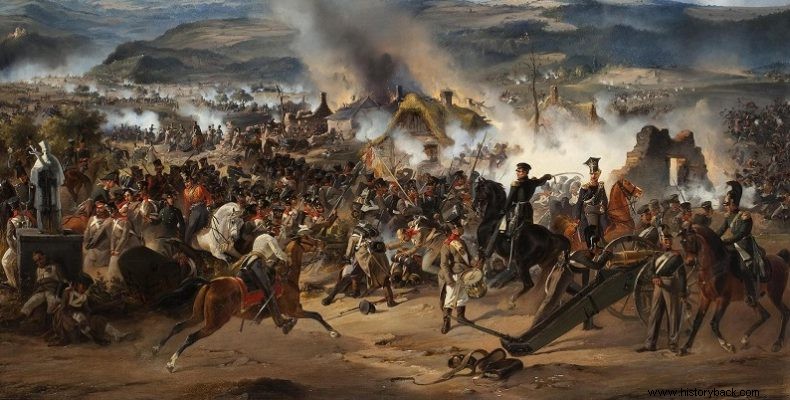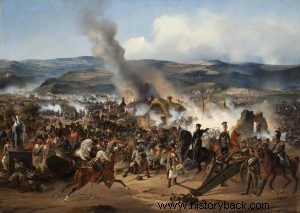
After his defeat in Russia in 1813, Napoleon returned to France and attempted to rebuild a new army. Numerically he succeeded by mustering over 150,000 men. However, in terms of quality, this army lagged behind dramatically. His great weakness was the lack of cavalry. Nevertheless, Napoleon managed to prevail, in the summer of 1813, in the Pyrrhic victories of Lytsen and Bausten, of the united Russian and Prussian forces. In the meantime the political situation worsened, with Austria leaning towards the anti-French coalition, eventually joining it as a member in late summer.
Now Napoleon would have to contend, on European soil, with the armies of three empires, bolstered by British gold and the Swedish Army, led by Bernadotte's ex-marshal.
Opposing Forces and Plans
Napoleon rejected the then-generous Allied peace proposals – they would have left him as King of France – and at the head of some 130,000 men marched into Germany to meet his forces already there. Around 100,000 French soldiers were surrounded in Germany and Poland. But the allies were also preparing.
Napoleon, despite the superiority of his opponents, was optimistic. In the late summer of 1813 he advanced as far as central Germany, reaching Saxony and making Dresden his base of operations. The French dictator believed that the allies, not having a common leadership, would be easy prey for his concentrated blows. Napoleon therefore decided to attack each allied army separately, taking advantage of its development on internal lines.
The maneuver on internal lines it had always been the pinnacle of Napoleonic strategy and Napoleon had applied it with incredible success on most occasions since 1796 in Italy and elsewhere. However, the problem was that the allied generals were already well aware of the Napoleonic way of fighting and precisely based on this knowledge they decided to react accordingly.
The allied leaders, the Austrian Schwarzenberg, with Radetzky's chief of staff, the Prussians Blycher and York, the Russian de Tolly and the now Swedish Bernadotte met twice in the small towns of Trachenberg and Reichenbach where they decided on their strategy. They ended up with the so-called Trachenberg-Reichnebach plan, the initiator of which was the Austrian general Radetzky.
His plan was simple and provided for the neutralization of the maneuvers on interior lines that Napoleon would implement. So based on the plan the three allied armies would line up north (Army of the North), east (Army of Silesia) and south (Army of Bohemia) of the French lines, constantly threatening the overextended lines of French transport. In this way Napoleon could never muster the forces and deliver a crushing blow against one of the opposing armies.
But even if it risked it the allied army that would be attacked would not accept the engagement and retreat. In response, Napoleon also divided his forces into three armies, the Berlin Army, in the north, the Bomber Army, in the east, and the emperor himself in the center.
Kachsbach, Kulm, Denewitz... three French disasters
When Napoleon left Field Marshal MacDonald with Bomber's Army to rush the bulk of his forces to Dresden, he believed that the experienced field marshal, with three army corps at his disposal, was able to cover the rear of the Imperial army, taking up positions on of the Bober River. Bomber's Army consisted of French, German and Italian allied divisions. Blycher immediately moved against him with 95,000 men. The encounter battle that followed took place around the village of Katzbach. General Yorke's dashing Prussian charge shattered the French lines. MacDonald was forced to retreat, leaving behind over 7,500 prisoners, 58 guns and hundreds of dead and wounded.
Meanwhile, Napoleon reached Dresden, defeated the Allies, and ordered General Vandam's army to pursue the defeated Austrians, Prussians, and Russians. However, the allied forces, with a completely successful offensive return, managed to surround the entire French army and disperse it, near the Kulm fortress. Over 10,000 Frenchmen were lost in the battle, along with 82 cannons, two "Eagles" and five flags. Vandam himself was captured by Russian mounted hunters and Cossacks. This defeat neutralized in the best way for the allies their own defeat in Dresden and whatever advantages Napoleon had gained from this victory.
These defeats forced Napoleon to change his plans. He decided to remain with the Guard and the bulk of his forces at Dresden, leaving MacDonald to control the river lines to the east and sending Field Marshal Ney north to Berlin in command of the Berlin Army. Ney met the Prussian national guard corps of General Towentsien and repulsed it. The Prussian national guards, however, did not let it go. They were regrouped by their brave commander and defended the ground bit by bit, waiting for General von Büloff's army corps to come to their aid.
So it happened. Byloff arrived at the right time, the time that the French had the illusion that they were winning. A particularly fierce battle ensued. The Denevic and the surrounding villages were captured and recaptured several times, with the lance. Soon the battle became general as French reinforcements led by Marshal Udino arrived, as well as allied, Prussian and Swedish reinforcements from the Army of the North. The French finally gave in and began to retreat disorderly from the battlefield, leaving behind over 22,000 men and 53 guns.
The allies were exhausted as well, having lost 10,000 men and so did not pursue the defeated. Nevertheless, the defeat at Denevic was just as serious as the one at Kulm. It was now clear that the allies were playing a game of cat and mouse with him, intending to wear him down with a series of concentrated blows against his generals and generals.

The battle at Kulm.
